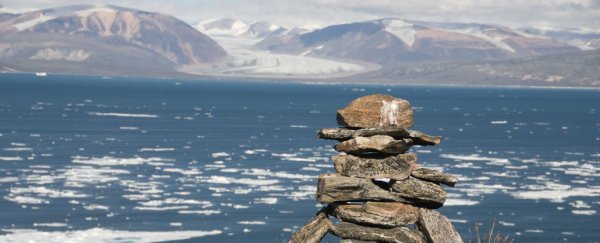A mysterious noise appears to be coming from the bottom of the sea near Nunavut in Canada, and local hunters are anxious, saying it's been scaring the wildlife away.
Described as a "ping", "hum", or "beep", the sound has been emanating from the Arctic for months, and the locals have gotten so desperate, they've asked the military to get involved. An active investigation is now underway.
The sound reportedly comes from somewhere on the sea floor in the Hecla and Fury Strait - a narrow channel of water in Nunavut, which is the newest, largest, and least populous territory of Canada, located right up north, next to Greenland.
In Nunavut, roughly 31,000 people - mostly Inuit - are spread over an area of 1,750,000 km2, and the territory boasts the world's northernmost permanently inhabited place, Alert.
Local tradition involves hunting large mammals such as seals, caribou, and whales, and the Hecla and Fury Strait is usually a prime location, because it's a polynya - an area of open water surrounded by ice, which many mammal species treat as feeding grounds and overwintering havens.
But that all changed during the summer, with locals reporting that the animals seem to have gone elsewhere this year - and say it was around the same time that the noise started to be heard.
"That passage is a migratory route for bowhead whales, and also bearded seals and ringed seals. There would be so many in that particular area," local government official George Qulaut told CBC News. "This summer there was none."
"That's one of the major hunting areas in the summer and winter because it's a polynya," added another official, Paul Quassa. "And this time around, this summer, there were hardly any. And this became a suspicious thing."
As often happens when something mysterious is afoot, and scientists haven't had the chance to explain it, conspiracy theories now abound.
Some are blaming the Baffinland Iron Mines Corporation, which extracts iron ore on Baffin Island, to the northeast of Nunavut.
Locals suspect that the sound is coming from sonar surveys being conducted by the mining company, but spokespeople have denied that it has any equipment in the water at this time.
Others blame Greenpeace, with suspicions that the organisation has snuck sonar devices in the channel to save wildlife from getting hunted. Greenpeace has also denied the allegations.
If the sound does actually exist - and let's be clear, researchers have not confirmed that at this stage - the big concern is that it's harming the wildlife.
Because unlike that strange, low-pitched sound researchers detected from the Caribbean Sea back in June, this doesn't appear to be natural.
Earlier this year, a landmark ruling in California found that the low-frequency sonar systems used by the US Navy for training missions violates the Marine Mammal Protection Act, because it negatively impacts whales, dolphins, and walruses who rely on sound to navigate the seas.
As director of the US National Resource Defence Council's marine mammal project, Michael Jasny, told Wired, "It's important to understand that the ocean is a world of sound, not sight."
And as a recent study found, certain species of fish appear to sing in chorus, from dawn to dusk, to call on mates, settle territorial disputes, and find food.
A blaring signal from the sea floor - that's reportedly so strong, it can reportedly be heard through the hulls of boats - could be doing untold damage to these communication systems.
Canada's Department of National Defence has opened an investigation.
"The Department of National Defence has been informed of the strange noises emanating in the Fury and Hecla Strait area, and the Canadian Armed Forces are taking the appropriate steps to actively investigate the situation," a spokesperson told CBC News.
Hopefully, we'll be able to get to the bottom of the mystery, because if there really is something down there that's been ringing out through the channel for months, we need to put a stop to it now.
